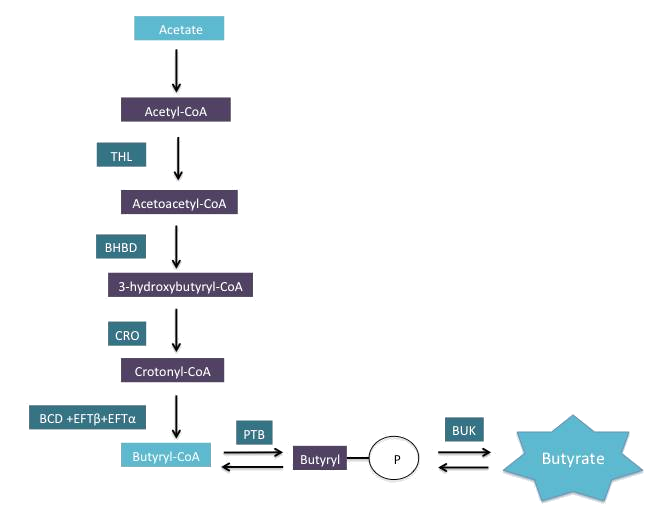Part:BBa_K1618021
Plac-THL-CRO-BHBD-BCD-EFTb-EFTa
K1618021 contains the coding sequences for the Thiolase,Crotonase, β-hydroxybutyryl-CoA Dehydrogenase,Butyryl-CoA Dehydrogenase,Electron Transfer Protein β and Electron Transfer Protein α from Coprococcus sp. (L2-50 DSM),under control of the LacI promoter. This construct builds the butyrate pathway (Figure 1) that converts acetyl-CoA into Butyry-CoA 1. At the last moment we realised that there was an EcoRI site on the gene sequence so we're working to fix this as soon as possible.
1. Louis P., Petra L., Pauline Y., Grietje H., and Flint H.J., 2010, Diversity of human colonic butyrate-producing bacteria revealed by analysis of the butyryl-CoA:acetate CoA-transferase gene , Environmental Microbiology, 12(2) p. 304–14..
Figure 1: The butyrate biosynthetic pathway.
iGEM THRACE'S 2023 CHARACTERIZATION
Usage and Biology
Short-chain fatty acids are vital metabolic byproducts generated through microbial fermentation of dietary fibers in the gut. Gut bacteria, particularly those belonging to the Firmicutes and Bacteroidetes phyla, break down these substrates through various metabolic pathways. There are several fermentation pathways leading to the production of SCFAs, including the glycolytic pathway, the pentose phosphate pathway, and the reductive citric acid cycle. In these pathways, bacteria metabolize sugars and other organic compounds to produce SCFAs as metabolic byproducts.
Acetate Production: Acetate is the most abundant SCFA in the gut. It is primarily generated through the acetyl-CoA pathway, where acetyl-CoA is converted into acetate via various enzymatic reactions.
Propionate Production: Propionate is synthesized mainly via the succinate pathway. Bacteria convert succinate, a metabolic intermediate, into propionate. This pathway is essential for maintaining energy balance and regulating blood glucose levels.
Butyrate Production: Butyrate is generated through several pathways, with the two main pathways being the butyryl-CoA:acetate CoA-transferase pathway and the butyrate kinase pathway. These pathways involve the conversion of acetyl-CoA and butyryl-CoA into butyrate.
From bibliographical research and various experimental data, we concluded that acetate and butyrate are the most profound and effective molecules for the treatment of depression, and generally the overall gut health. Therefore, the design of a probiotic that would include a vector with the gene cluster of the butyrate-producing metabolic pathway, could lead to the production of a psychobiotic that could treat depression. Our selected strain Lactobacillus rhamnosus GG produces only acetate.Lactobacillus rhamnosus GG is a very common probiotic that is Generally Recognised As Safe (GRAS) and our dry lab bioinformatic analysis found that the concentration of the Lactobacillus rhamnosus bacterium is low on depressive people. Thus it made us focus on this probiotic for its utilization as a host of the butyrate-producing pathway.

Pathways for the synthesis of SCFAs. Lange, O., Proczko-Stepaniak, M. & Mika, A. Short-Chain Fatty Acids—A Product of the Microbiome and Its Participation in Two-Way Communication on the Microbiome-Host Mammal Line. Curr Obes Rep 12, 108–126 (2023). https://doi.org/10.1007/s13679-023-00503-6
Characterization
For the characterization of the old sequence and its future use as a control for the characterization of the new part, we cloned the old part's insert into our pNZ8149 food-graded vector, and with this, we transformed E.coli K-12 strains and Lactobacillus rhamnosus GG strains. Then after the bacterial cells were cultured for 24h in MRS and MRS culture medium that included inulin, we measured the production of the SCFAs with HPLC. The results are shown below [Figure 2]. Also, in order for our experiments to be more accurate we measured the production of SCFAs with HPLC from E.coli K-12 strains and Lactobacillus rhamnosus GG strains that they had not been transformed[Figure 1]. Therefore we had one extra control test for the bacteria that had been transformed with the old part.

Figure 1.The results obtained from the HPLC of the bacteria strains that weren’t transformed.

Figure 2. The results were obtained from the HPLC of the bacteria strains that were transformed with the plasmid containing the old part.
What we can understand from the results is that the old part still seems to be completely ineffective in producing butyrate. This is encouraging because our newly designed part (BBa_K4989011) could potentially have much better performance.
Sequence and Features
- 10INCOMPATIBLE WITH RFC[10]Illegal prefix found in sequence at 229
Illegal EcoRI site found at 3159 - 12INCOMPATIBLE WITH RFC[12]Illegal EcoRI site found at 229
Illegal EcoRI site found at 3159
Illegal NheI site found at 1167
Illegal NotI site found at 235
Illegal NotI site found at 3841 - 21INCOMPATIBLE WITH RFC[21]Illegal EcoRI site found at 229
Illegal EcoRI site found at 3159
Illegal BglII site found at 1415 - 23INCOMPATIBLE WITH RFC[23]Illegal prefix found in sequence at 229
Illegal EcoRI site found at 3159 - 25INCOMPATIBLE WITH RFC[25]Illegal prefix found in sequence at 229
Illegal EcoRI site found at 3159
Illegal XbaI site found at 244
Illegal AgeI site found at 1338
Illegal AgeI site found at 3354 - 1000COMPATIBLE WITH RFC[1000]
| None |

